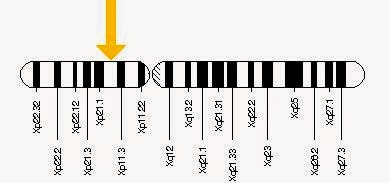Sunday, July 13, 2014
The Memory Switch
Our ability to learn and maintain memories hinges upon a long-term increase of efficiency in neural transmission, a process called Long Term Potentiation (LTP). In this state, the synapse (connection between two neurons) is made more sensitive to stimulation, and thus the post-synaptic (receiving) neuron is more likely to fire in the future.
The physical changes underlying this adaptation are controlled by a chemical chain reaction triggered when calcium enters a neuron, activating a key protein on-off switch called a kinase.
One major family of kinase switches are the calcium-activated Ca2+ responsive kinases (CaMKII). These protein switches help control critical life functions like muscle contraction, neurotransmitter release, stored energy (glycogen) use, and control of transcription factors - which jump-start the reading of our DNA's "blueprints" for protein manufacture.
When calcium activates CaMKII, the kinase "revs up" into an self-maintaining active state, even after the triggering calcium is gone. This self-maintaining activity is the brain's "molecular memory switch", and malfunctions have been linked to heart arrhythmia and Alzheimer’s disease.
In 2014, University of Bristol scientists used common fruit flies (Drosophila) to pin down the primary gene and molecule responsible for controlling the memory switch in the hippocampus, the primary memory and navigation center found deep within the human brain. Prior to this revolutionary discovery, the specific trigger for LTP had been a long-standing mystery.
Because Drosophila breeds and matures so quickly, it is very efficient to use as a model in studying biochemical processes. Drosophila also shares a great deal of common DNA with humans - over 60%, primarily the homeotic genes that direct embryonic growth according to a specific, symmetric body-plan.
Bristol Professor James Hodge and his colleagues used trial and error to suppress memory-related regions of fruit fly DNA until they pinpointed a specific region - a gene called CASK - the cellular blueprint for synthesizing the protein memory switch.
In humans, cellular DNA is bundled in tightly-wound, microscopic molecular strips called chromosomes. Of these, the X and Y chromosomes regulate the development of sexual characteristics in humans. The CASK gene is found on the short arm of the human X chromosome. It is a unique combination of 404,253 building blocks called nucleotides lined up and joined along a sugar-phosphate backbone molecule that, if stretched out, would be about two inches long.*
The CASK gene contains instructions for synthesizing the calcium/calmodulin-dependent serine protein kinase (CASK), a unique shuffling of 926 linked molecular building blocks (amino acids) found mainly in the brain's neurons, where it assists in regulating neurotransmitters and the movement of charged atoms called ions, critical for neuron-to-neuron signal transmission. It also helps control the protein-manufacturing activity (expression) of other genes involved in brain development. Mutated versions of the CASK gene have previously been linked to several severe learning disorders.
Fruit flies can learn to search for food and to avoid painful stimuli just like any other complex animal, so Dr. Hodge's team tested the flies' learning and memory capacities using two separate odors. One smell would lead to food, and the other to a mild shock. They discovered that about 90 percent of the flies could learn to avoid the shocks after five trials, and the lesson would stay with each fly up to a week - a significant portion of their entire lifespan.
Switching off CASK and CaMKII production in Drosophila's memory centers caused the flies to be unable to remember to avoid the shock even three hours later. But replacing fruit fly CASK genes with the human version (which is 80 percent identical to Drosophila's) enabled specimens to learn normally again.
Says Dr Hodge, locating the CASK-CaMKII memory switch is a major first step in finding new treatments and drugs for stopping or even reversing the effects of memory loss.
Sources: "Scientists identify brain's 'molecular memory switch'", press release, March 28, 2013, University of Bristol
"Genes: CASK", 2011-2014, Genetics Home Reference, US National Institutes of Health
"Length of a Human DNA Molecule", The Physics Factbook, Glenn Eler, Steven Chen, et al
Please note that this material is a copyrighted excerpt from The Path: Origins
* interestingly, if all the DNA from your body's 1013 cells were stretched out into a single strand, it would be the equivalent of just over 133 AU - astronomical units - or 133 trips from the Earth to the Sun at its average annual distance of 149597870.7 kilometers or nearly 93 million miles.
Subscribe to:
Post Comments (Atom)

No comments:
Post a Comment